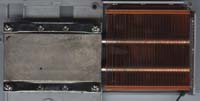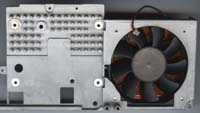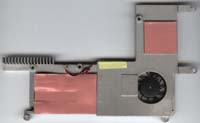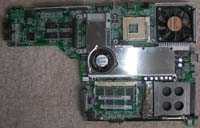Construction - Under the Hood
We pointed out some striking similarities with the outside of the WinBook J4 and the ECS i-Buddie 4 but taking the system apart quickly reveals that all these similarities are mostly cosmetic. The reason: the WinBook J4 is a notebook machine designed to run on battery power as well, unlike the ECS i-Buddie desknote systems.
The J4 system that we received was a fully loaded model. It came outfitted with a desktop Pentium 4 processor running at 2.4GHz, 512MB of SDR SODIMM memory, an ATI Mobility Radeon 7500 graphics chip with 64MB of memory, a 15" SXGA+ TFT LCD, and integrated 802.11b wireless. Naturally the J4 is available in a variety of configurations but there are really two J4 models out there. The J4 that we received includes the features listed above and is based off the Intel 845 platform. WinBook also offers another J4 that is based off the SiS 650 chipset, uses the SiS 650 integrated graphics solution, and is outfitted with DDR SDRAM. Obviously the 845 based J4 is the higher performing part with its discrete video chip and also caries with it a higher price.
The 2.4GHz Pentium 4 that powered our J4 ranks as the fastest processor we have seen in a mobile system to date. The chip operated on a 400MHz front side bus, unlike the newer 2.4B GHz Pentium 4 chips that run on a 533MHz front side bus. In a mobile system the speed sacrifice taken by going with the lower front side bus speed may be somewhat worth it being that the 133MHz x 4 FSB would draw more battery power than the 100MHz x 4 one.
The WinBook J4's CPU is easily accessed by removing the CPU access panel on the bottom of the system and removing the four screws holding the heatsink in place. This means that the J4's CPU can be replaced with the turn of a few screws and the lifting of a lever. The J4 should be able to accept any 400MHz FSB Pentium 4 CPU but you will be somewhat limited as the 400MHz FSB Pentium 4 processors probably not going to go much faster than 2.4GHz. For this reason it may be worth wild for some users to go with a slower J4 system and upgrade the processor to a 2.4GHz Pentium 4 down the road when more speed is desired.
The Pentium 4 processor is cooled via a heat spreader connected via copper heat pipes to a large copper heatsink. Air flows across the heatsink from top to bottom thanks to a large Sunon 60mm x 60mm x 10mm fan. Keeping the Pentium 4 processor cool in such a small space is not an easy task. It is for this reason that the Sunon fan used by the J4 is the same size as the CPU fans found in many desktop machines. The Sunon fan is temperature controlled and only spins at a rate necessary to properly cool the CPU. This is helpful being that the fan is rather noisy when spinning at its full speed. We found that the majority of the time the fan did not spin at full speed and was not overly loud.
Once the heatsink is removed, the Northwood Pentium 4 CPU is revealed. The chip is mounted in a standard mPGA 478 socket and can be removed just as a desktop CPU can be removed.

So far the J4 seems very similar to the i-Buddie systems, but like we said the two are quiet different. The differences were revealed as soon as we took out the J4's motherboard. Unlike the i-Buddie systems, which used the majority of its motherboard real-estate attempting to fit desktop components in a small package, the J4's motherboard is truly a mobile one, with a discrete video chip, video memory, SODIMM slots, and more.
To power its desktop Pentium 4 processor, the J4 calls upon the desktop Intel 845 chipset. We were disappointed when we learned that the 845 chipset on the J4 was mated with an SDR memory bus. We have already shown that the Pentium 4 will take advantage of every bit of memory bandwidth it can get so we knew that the SDR memory bus on the J4 would be holding it back. We would have much rather the J4 used a DDR memory bus with the 845 for even the mobile Pentium 4 chipset, the 845MP, makes use of a DDR memory bus. Only benchmarks would tell how much the SDR bus held back the J4 in application and 3D performance.
The 845 northbridge is located below the CPU socket and is actually covered and cooled by a large metal heatsink and fan. The 845 northbridge gets fairly warm, even warm enough to justify use of a heatsink on desktop systems. It was therefore no surprise that the northbridge in the cramped J4 needed the extra cooling supplied by a fan. It is the intake for this fan that we see on the bottom of the J4. This cooling device was used to cool the three phase voltage regulator on the ECS i-Buddie products but goes to much better use keeping both the northbridge and the video chip cool.
 |
As we mentioned, the ATI Mobility Radeon 7500 is also found beneath the metal cooling plate. We first got a chance to take a detailed look at the Mobility Radeon 7500 in the Compaq Persario 2800T and were thoroughly impressed with the product. Not only does the Mobility Radeon 7500 boast blazing fast graphics performance it also includes many power saving features that help conserve battery life. For these reasons we were excited to hear that the WinBook J4 featured the ATI Mobility Radeon 7500 with 64MB of video memory at the heart of its design.
When we started testing the J4 in 3D games we felt that something was amiss. We didn't know why but our J4 running at 2.4GHz was performing slower than the 1.7GHz Persario 2800T. We knew that the SDR memory bus could not have been slowing the computer down to the extent that we saw, so the next step was to look at the video chip. It was here that we found the root of our problem.
Although the ATI Mobility Radeon 7500 is able to run at a 270MHz core speed and a 183MHz DDR memory bus clock it is up to the hardware manufacturer what speed the graphics part actually runs at. This means that not every Mobility Radeon 7500 has to run at the 270/183MHz speeds; a fact which can be useful when migrating the chip into low power solutions where 3D video performance is not of utmost concern. It also means that some notebooks even in the desktop replacement category may use lower clocked Mobility Radeon 7500 chips in an attempt to lower cost. For whatever reasons, cost issues, cooling problems, we can not be sure, the WinBook J4's Mobility Radeon 7500 ships underclocked.
The unexpected performance drop stemmed from the fact that the Mobility Radeon 7500 in the J4 runs only at a 260MHz core speed and a 143MHz DDR memory bus speed. Again, we are not sure why the J4's Mobility Radeon 7500 runs lower than the maximum clock speeds of the chip but it does. As you will see in the performance section this does hold the J4 back.

In addition to the northbridge and video chip mounted on the bottom of the J4's motherboard there were other chips located here.
On the left side of the system one can see 32MB of the 64MB video memory that the J4 uses. The memory chips are ESMT 5ns chips, 8MB in density each.
Towards the front of the motherboard lies the two SODIMM slots. These slots can accept up to 512MB of SDR memory each making total system memory reach 1024MB. Our system came with 256MB sticks in each slot, totaling 512MB of system memory. These slots are easily user accessible thanks to the access panel on the bottom side of the notebook. To the right of the memory is the single PCMCIA slot. Underneath the PCMCIA's metal housing is a Ricoh R5C551 chip that controls the PCMCIA functions of the slot. This chip also gives the J4 its firewire capability.
Two other chips are mounted on the back side of the J4's motherboard. The first of these is a National Semiconductor PC87391 super I/O controller that powers the floppy, parallel, and serial port controllers among other things. The second is an O2Micro OZ165T chip that controls the audio CD playback of the notebook while the system is powered off.
















2 Comments
View All Comments
Poopship - Tuesday, December 18, 2012 - link
i-BuddiePoopship - Tuesday, December 18, 2012 - link
Why was everything expensive crappy plastic garbage. desktop p4 lol